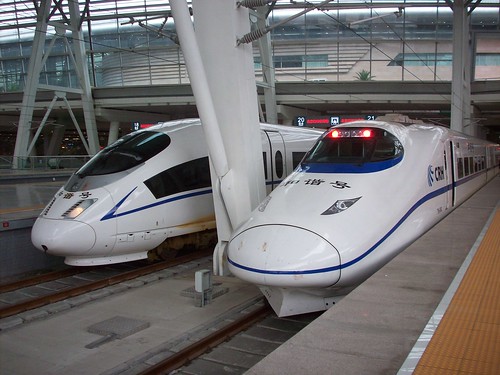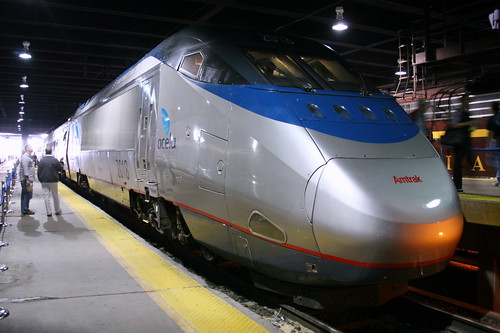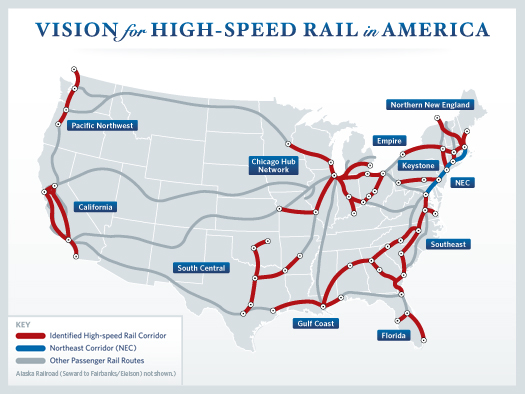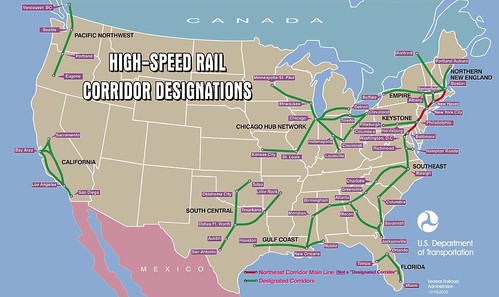Chinese High-Speed Rail investment dwarfs US investment; Government’s commitment to passenger rail makes US plan look a little silly
(Source: The Infrastructurist & Asia Times)
The Chinese are at it again. The Asian juggernaut is rolling ahead with its investment in beefing its modern infrastructure – this time with a massive investment in railways. With the dedication and determination that has become a hallmark of all things Chinese, be it sports or the development, the country has proved time and again that it is among the best in the world. Dithering and doing things half-way are not among the national character flaws that might be pinned on the Chinese. And, perhaps, they’re already at it with this plan to build the world’s largest high-speed rail network.
China’s rail links totaled 76,600km by end of 2006. But most of them were built at least 30 years ago and some even date back to the early 20th century. The economic boom of the past two decades has generated soaring demand for rail transportation. In 2006, China’s rail network handled 25% of the world’s cargo and passenger travel, although the country’s railway network only accounts for 6% of the world’s total by mileage. 
In 2006, China’s railway network carried 662.2 billion passenger-kilometers – 2.7 times that of Japan – while it carried 2.87 billion tons of freight, a billion tons more than in the US, and 4.8 times that in India. To cope with the skyrocketing demand for rail transport, the Chinese government has kept expanding its plans for rail construction. As of March 31, China has committed $259 billion to building its high-speed rail network project, and plans to spend nearly a half trillion dollars more in the next three years, boosting the total investment to $730 billion by 2012.
Of the Chinese investment, at least $1 billion is going to the German conglomerate Seimens for the purchase 100 high speed train sets. They will be, on average, 16 cars–or 1300 feet–in length, capable of carrying 1000 passengers, and capable of traveling 218 mph. Moreover, they will be running on tracks designed to accommodate that speed. Unlike, say, the Acela. Ultimately, the Chinese government plans to buy 1000 high speed trains to run on a track network of around 25,000 miles.
A little context here: The US–a country with a per capita GDP about 16 times that of China–has set rail as a national priority and has committed… $13 billion. Or, about 2 percent as much in China. This, of course, is in a place where it costs a hell of a lot more to get anything done. In the U.S., President Obama’s decision to make high-speed passenger rail service a centerpiece of his transportation agenda is funded in part through the recently passed $787 billion stimulus plan including a total of $8 billion for improvements in the U.S. rail system. The Obama plan also proposes a separate five-year, $5 billion investment in high-speed rail as part of the administration’s suggested fiscal year 2010 budget (FY10 budget outline) to make a down payment on constructing enhanced rail network.




![Spain's system of 218-mile-an-hour bullet trains, the AVE[mdash ]meaning 'bird' in Spanish[mdash ]has increased mobility for many residents, though critics say it has come at the expense of less-glamorous forms of transportation.](http://s.wsj.net/public/resources/images/NA-AX208_FASTRA_G_20090419183055.jpg)




